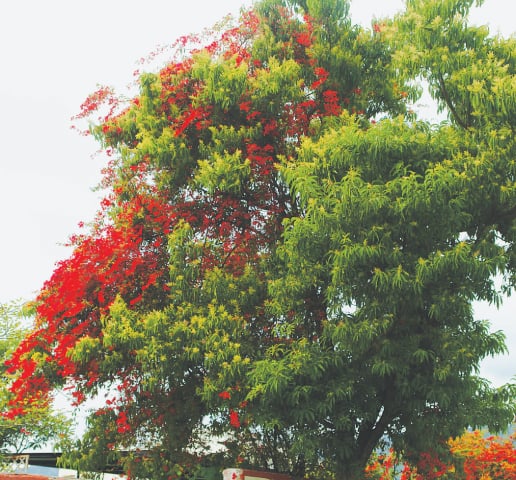The summer monsoon tree-planting season is officially underway, so let’s take a look at some of the trees, climbers and shrubs that can be planted from now until approximately mid-September, to help re-green our city, town and home environment.
With the emphasis on indigenous varieties, plus those which have proved their climatic and environmental suitability over the years, there is a wealth of trees to choose from, although some of them may prove difficult to track down in nurseries. If the latter is the case, then search for a seed source instead: sown now, the seed should result in saplings that will be ready to plant at this time next year.
When selecting tree, climber or shrub saplings, choose only those that are in tip-top health. Do not let the nursery person con you into buying anything that is even slightly damaged, shows any sign of pests or diseases or which has weak growth. Only buy pot-grown specimens at this time of year, leaving those being nurtured directly in the ground for planting over winter months.
Update yourself on the best ways to do monsoon planting
Prior to investing in trees, climbers or shrubs, please give serious thought to the height, width and spread they are likely to achieve at maturity. Also keep in mind, especially with trees, that their below-ground root systems can be as much as twice the size of above-ground growth. The latter point is of prime importance when planting in built environments where both above and underground cables, water and sewage pipes, building and wall foundations, etc, must be given due consideration, as must road and footpath surfaces as these can be cracked and eventually destroyed by invasive roots.
Planting holes for trees, climbers and shrubs are best prepared at least two weeks before actual planting takes place — this gives the soil and added materials time to settle and blend. But as this isn’t always feasible (especially if holding a local tree planting campaign) it can also be done, with correct care and attention, at the time of planting.
Preparing a planting hole: Dig a hole that is approximately twice the depth and twice the width of the sapling’s existing or estimated roots, removing any stone debris and weeds in the process. Mix the removed soil with either organic compost or fully-rotted organic manure — a 50/50 mix is perfect. If possible, drop a medium-sized, pre-boiled (therefore totally cleaned of fats/meat residue) meat bone or a handful of equally clean chicken bones into the base of the hole and then fill with the soil/compost/manure mix up to the half-full mark. The bone/s provide the sapling with slowly released minerals for some years to come and get them off to a good strong start in life. Pour in enough water to fill the hole, allow it to soak in and then, after gently spreading out its roots, carefully insert the sapling. The sapling should be planted at the exact same depth as it was planted in its pot: meaning that in its new home, the base of its trunk/stem should be just at soil level — neither above it nor below it but equal to it. It may be necessary to fill more than half of the planting hole before this balance is achieved but, once achieved, carefully fill soil in around the fragile sapling roots until the hole is full. Pour on more water, allow to settle down. Add more of the soil mix if needed. There is absolutely no need to stamp down the soil around the sapling — doing so can damage its roots. Watering the soil into place is the best option.

Two important things I must point out before going further.
If the sapling needs support, the support should be placed in the hole, before the sapling itself is planted; putting the support in afterwards will damage the roots.
Saplings, especially tree saplings planted outside gardens proper, need regular irrigation for the first two to three years otherwise losses will be extra high. To assist with this, and to cut back on time spent on manual watering, a drip system using recycled water bottles can be improvised. Simply make a few small holes in the screw of a bottle cap and then cut away half of the bottle base, turn it upside down, quarter fill (through the half-open base) with rough sand/gravel and ‘plant’ this bottle upside down, with the base slightly above ground level, at the same time as you put in the sapling. When done, fill the bottle with water; this will seep down through the sand/gravel to drip water into the sapling roots right where it is needed. Topping up the bottle every few days should suffice.
Tree species to consider include the following but, this being a huge country, do check on localised suitability first: Coconut, Sapota (Chikoo), Annona squamosa (Sharifa), Date palms, Guava, Mango, Bauhinia (Kachnaar), Melia azadiracta (Neem), Ficus indica (Banyan), Ficus infectoria (Pakar), Ficus religiosa (Peepul), Moringa pterygosperma (Drumstick tree), Tamarinda indica (Imli), Cassia fistuala (Amaltas) and Poinciana regia (Gul mohr), Pithecellobium dulce (Jangal Jalebi), Tecomella undulata (Lohirro), Salvadora persica (Miswaak), Ziziphus mauritania (Baer), Crateva religiosa (Barna), Prosopis cineraria (Jand), Acacia nilotica (Baboul), Capparis dendua (Kareer), Almond, Gondni and Khirni.

Climbers: Asparagus plumosus, Bougainvillea, Epipremnum aureum (money plant), Philodendron, Monsteria deliciosa (Swiss cheese plant) and other climbers with ornamental leaves. Flowering climbers are best transplanted during the winter season.
Shrubs: Acalypha, Aralia, Clerodendron, Eranthemum, Panix and many other shrubs grown for the beauty of their leaves. As with climbers, flowering species are best planted in the winter months when they are semi or fully dormant.
Please continue sending your gardening queries to zahrahnasir@hotmail.com. Remember to include your location. The writer does not respond directly by email. Emails with attachmentswill not be opened.Commercial enquiries will be ignored.
Published in Dawn, EOS, July 15th, 2018

















































